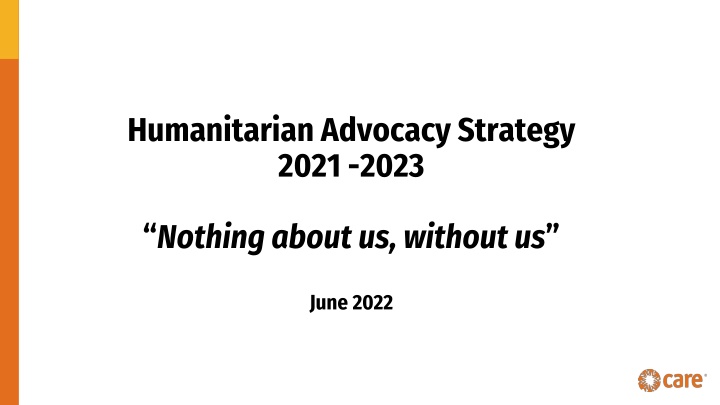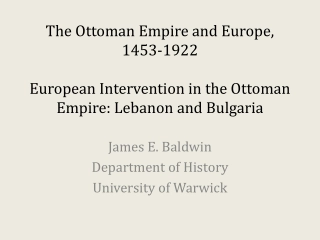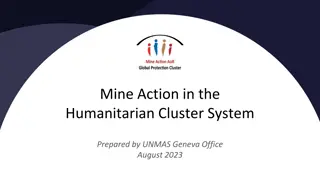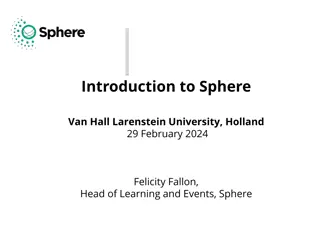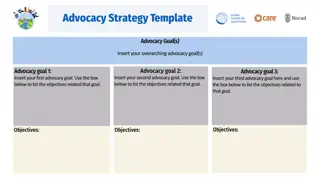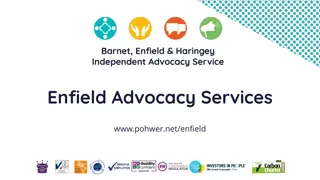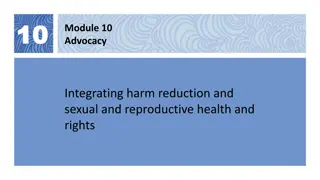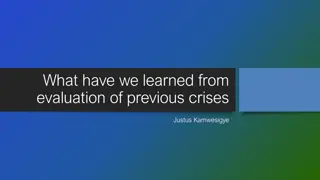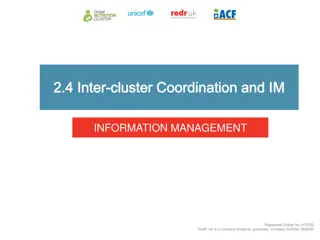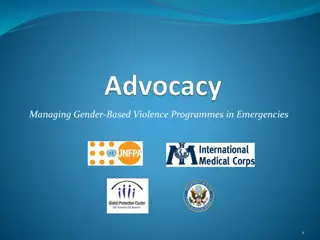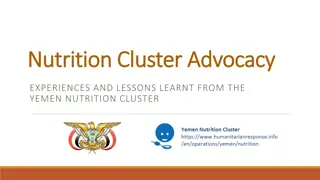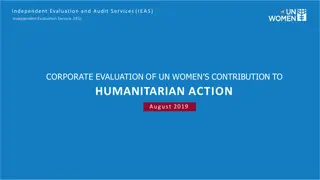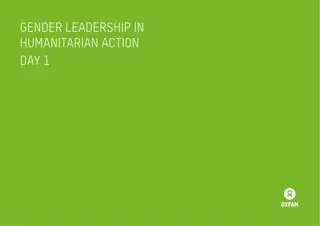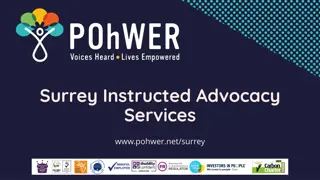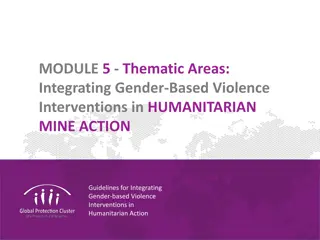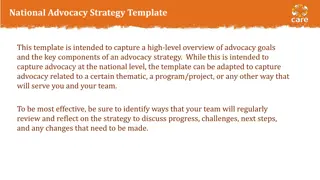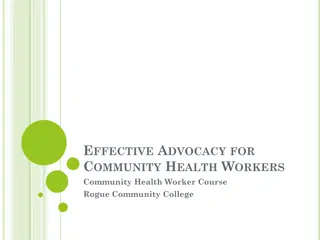Humanitarian Advocacy Strategy 2021-2023 Overview
In the realm of humanitarian advocacy, the strategy for 2021-2023 focuses on meeting diverse needs in crises, protecting rights, and enhancing system agility and responsiveness. Key issues like Gender Equality and Empowerment of Women and Girls are addressed through policy advocacy positions to drive positive change.
Download Presentation

Please find below an Image/Link to download the presentation.
The content on the website is provided AS IS for your information and personal use only. It may not be sold, licensed, or shared on other websites without obtaining consent from the author.If you encounter any issues during the download, it is possible that the publisher has removed the file from their server.
You are allowed to download the files provided on this website for personal or commercial use, subject to the condition that they are used lawfully. All files are the property of their respective owners.
The content on the website is provided AS IS for your information and personal use only. It may not be sold, licensed, or shared on other websites without obtaining consent from the author.
E N D
Presentation Transcript
Humanitarian Advocacy Strategy 2021 -2023 Nothing about us, without us June 2022
Key resources Humanitarian Impact Area Strategy There is also a one-pager; Humanitarian Impact Area Advocacy Strategy Power Point: this document Recording of an induction session based on this PP in French: here Recording of an induction session based on this PP in English: here 2 March 5, 2025
Humanitarian Impact Area Advocacy Strategy 2021-2023 Nothing about us without us (The strategy and all related detailed position papers are available on Share Point here) CARE and our partners programming and advocacy will influence change in the wider humanitarian system by pursuing the two following and mutually reinforcing advocacy objectives: Advocacy objective 1: The diverse needs of all people affected by crisis are met and their rights under international humanitarian law are protected; Advocacy objective 2: The humanitarian system is more agile, better prepared for and responsive to humanitarian crisis, more inclusive, locally- led, and accountable
Issue 1: Gender Equality and the Empowerment of Women and Girls (GEEWG) in Humanitarian Action remains marginal See detailed policy advocacy position here. Issue 1.1. The human rights imperative to prioritize women and girls in crisis remains undressed Key policy asks: - Approach GEEWG in HA as a combined rights and needs-based framework under the umbrella of relevant legal & normative instruments and internationally-recognized declarations & frameworks (CEDAW, SDG5, Leave no one behind, WPS) rather than as a transversal, technical, nice to have issue; Be mindful of not instrumentalizing GEEWGiHA; - Address SRHR and GBV as fundamental rights issues, even in emergencies; Issue 1.2. Limited participation and leadership of crisis affected women and girls & their organizations Key policy asks: - IASC humanitarian leadership should support existinglocal/national CSOs and women s organizations, networks & fora to accelerate women s participation and localization; - Increase diverse women and girls direct, substantial and meaningful participation and leadership in humanitarian coordination structures at all levels local to global; - Support & scale-up models (e.g. WLiE, VSLAiE) that increase women s participation in all spheres (private, household, community etc) as enabler to participation in HA; - Address gender discrimination & patriarchy in the humanitarian system & within individual agencies so they are practicing what they preach in terms of GEEWG;
Issue 1: Gender Equality and the Empowerment of Women and Girls (GEEWG) in Humanitarian Action remains marginal (continued) Issue 1.3. Data & accountability gaps on GEEWG Key policy asks: - Systematize RGAs & GBV risk assessments & collection of SADD data to inform HRPs / RRPs; - Step up investments in AAP & PSHEA, ensuring accessibility and user-friendliness of Feedback, Complaints and Reporting (FCR) systems; Issue 1.4. Gender unaware and ineffective interventions: Key policy asks: - Donors & humanitarian actors must ensure GBViE response and SRHiE (MISP) are considered essential services with uninterrupted availability & accessibility, even during epidemics - Gender responsive and, when possible gender transformative approaches, programs & models (e.g. VSLAiE, CVA, WLiE, EMBiE, SAA, Sasa) must be funded and scaled up, even during emergencies and particularly in protracted crisis; Issue 1.5. Insufficient funding for GEEWG in humanitarian action Key policy ask: - Harmonize the Gender & Age Marker & ensure it is adopted by all humanitarian actors to enable tracking progress on GEEWG targeted and GEEWG mainstreamed funding in HA; - Measure impact/benefit of GEEWG programs on women and girls to help increase funding. - Increase funding for GEEWG targeted interventions in priority crisis;
Issue 2: Humanitarian space and Protection of Civilians (PoC) under threat See detailed policy advocacy position here. Issue 2.1. Ever growing humanitarian access challenges: Key policy asks: - States particularly humanitarian donors must step up efforts to safeguard humanitarian space & encourage their own and other states accountability to international law; - Crisis affected countries governments and parties to conflict (incl. non state armed actors) must facilitate unhindered humanitarian access to people in need and must protect humanitarian workers, assets, and operations at all times (IHL); - Localization is not an access solution: risks must be shared with, not transferred to, local actors; the specific risks of women s organizations must be recognized and addressed; Issue 2.2. Protection of Civilians (PoC) denied Key policy asks: - Conflict parties must minimize the effects of conflicts on civilian population and objects (IHL). Those who fail to protect civilians and humanitarian workers must be held accountable; - Sexual violence is increasingly used as a weapon of war. Conflict Related Sexual Violence (CRSV) prevention and response efforts must be proportionate to the scale of the problem (the WPS framework); Issue 2.3. Growing protection needs of displaced populations (see detailed policy advocacy position): Key policy asks: - Global leadership must ensure IDPs and refugees protection under the relevant international and domestic legal instruments; - The specific needs and risks of displaced women and girls must be addressed.
Issue 3: Deepening Humanitarian Financing Gap See detailed policy advocacy position here Issue 3.1. Need to urgently deepen and broaden the humanitarian financing base & operationalize HDP Nexus Key policy asks: - Donors share responsibility for many of the world s humanitarian crisis and must therefore share the burden for responding to them. Therefore, donors must uphold ODA commitments and ODA should prioritize Fragile and Conflict Affected (FCA) settings, where it is most needed; - Targeting ODA to FCA settings needs to be accompanied by increased flexibility and agility of donor funding and financing to advance Nexus financing. Further, to support Nexus operationalization and programming in practice, donors & UN agencies must also conduct more joint assessments, analysis & planning (e.g. multi year HRPs in protracted crisis settings) at crisis and capital level. - Gender responsive climate, risk and forecast based financing, particularly adaptation finance and funding for loss and damage that aim at preventing and reducing risks (e.g. disaster risk reduction, Anticipatory Action, early warning, preparedness interventions) and at building resilience must be scaled up; - A more predictable, timely, flexible revenue stream for humanitarian action is also needed, both for long term protracted crisis in FCA settings and to respond timely to new rapid onset disasters. Therefore, actors must urgently mobilize additional responsible domestic and international resources (e.g. Islamic social finance, remittances, interest free or low loans, etc.) which complement, rather than replace, traditional international public humanitarian financing.
Issue 3: Deepening Humanitarian Financing Gap (continued) Issue 3.2. Limited progress on traceability of humanitarian funding; Key policy asks: - Improve traceability of donors funding through all transactions to final responder, and overall accountability on funding flows for all donors & funding agencies; - In so doing, accessibility and efficiency of the systems designed to improve transparency(IATI and OCHA s FTS) should be assessed, particularly in light of their appropriateness and user-friendliness for frontline organizations. Issue 3.3. Limited direct funding to frontline implementers Key policy asks: - Donors must increase direct funding to all frontline responders, international, national and local by scaling up direct NGO financing modalities that have proven successful in delivering both quantity and quality funding (such as funding NGO consortia & initiatives, e.g. Start Network, Program-Based Funding approaches). - While supporting localization, donors should continue to directly fund INGOs, where and when needed, capitalizing on INGOs operational presence & capacity to quickly respond in contexts with limited local capacity. Whenever possible, this direct funding to INGOs should include explicit localization objectives and funding for capacity sharing with national and local actors. - When passing funding through UN agencies and appeals, donors should hold UN agencies accountable for the timely granting of funds and cascading of flexibility measures to Implementing Partners. Issue 3.4. Gender unaware localization is leaving women s organizations behind (See detailed policy advocacy position here) Key policy asks: - Donors and international humanitarian actors (INGOs, UN agencies) must increase the volume (at least 25%) and the quality (more predictable, multi year, more flexible, less earmarked, covers all direct and indirect costs) of humanitarian funding going as directly as possible to national and local actors, including and particularly to women s & other crisis affected people s organizations(Grand Bargain, C4C). - They should also formally & publicly commit and report against set agency level targets (based on their current situation / baseline, on their mandate) of humanitarian funding going to national and local women s organizations (a 4% target was recommended at the 2016 WHS).
Linking with Women, Peace and Security - WPS is not strictly a humanitarian programming & advocacy issue and is relevant across the HDP Nexus & particularly in FCA settings, - So this strategy refers to our Women, Peace and Security Policy Advocacy Position Paper, December 2020 where relevant, given alignment between WPS priorities (participation, protection, prevention and relief and recovery) and the issues in this strategy (participation, protection, GBV / SRHR, etc); - Framing relevant issues under the legally binding character of the WPS normative framework can strengthen our humanitarian advocacy.
Key principles & main advocacy tactics Walking the talk (closing gap between advocacy and our own practice; internal advocacy) Driven and inspired by Feminist principles (see below notes) Ceding space to women s organizations, letting them set the agenda (and managing trade-offs for visibility) Cautiously Bold, continuously balancing benefits of speaking out versus potential harm on people in need, CARE & partners staff and protecting our operations so that we can continue to save lives. As a dual mandated organization, coherently balancing advocacy on root causes (drivers of conflict especially how gender inequality contributes to humanitarian needs) and needs (humanitarian imperative). Evidence based (advocacy on priority issues is informed by evidence from our priority crisis (Currently Venezuela, Central America Triangle, Central Sahel (Burkina, Niger, Mali), Nigeria, Syria, Yemen, Ethiopia, South Sudan, Sudan, Somalia, DRC, Bangladesh, Myanmar.
Who does Global Humanitarian Advocacy? A cross-CARE, multidisciplinary team leads advocacy efforts CI Secretariat (CI Head of Global Advocacy, Ebony Riddell-Bamber): Geneva: Humanitarian Impact Area Advocacy Lead & UN Geneva Rep (Delphine Pinault),; New York Head of office & UN Rep (Vanessa Jackson) Brussels EU office (Celine Mias Head of office, Julieta Gonzales & Carolina Morgado); all only a % time and based on EU and European members interest), CMPs at capital level (DC, London, Paris, etc) but few (except CUSA) have dedicated humanitarian advocacy capacity; Regional Advocacy positions Crisis affected countries staff (few have dedicated advocacy positions) Partners: INCREASINGLY IMPORTANT Different parts of the organization contribute and support: Regional staff: RDs, DRDs to some extent, Regional Humanitarian Coordinators; Crisis affected countries staff (CD, ACDs, few country have dedicated specific advocacy staff); Technical and sector specialists, notably on Gender (Isadora & GiE team) and priority sectors (see spaces / clusters where they engage in other slide); Humanitarian program staff, CARE Emergency Group staff; Other supporters in CARE Members National Directors, Humanitarian Directors, Program Directors
March 5, 2025 How do we do it? Largely lobbying by leveraging the strategic spaces, events & actors we have access to (e.g. direct engagement & briefings of donors & UN & EU MS, UN agencies, UN Security Council, EU Council, global IASC structures, Grand Bargain, Charter For Change; etc) Directly engaging and through NGO consortia (ICVA, SCHR and InterAction); Combination of private and public advocacy (weighing risks); Often and preferably collective effort; When possible, supported by communication products to amplify (PRs etc); Some campaigning (e.g. SLIC) but still limited; Collaboration with technical staff sitting in clusters and technical WGs; Internally: CI-crisis specific advocacy groups / calls / teams channels for priority crisis; Some thematic groups / CoP (CI-WPS advocacy, CoP on safeguarding humanitarian space, Humanitarian Partnership CoP, monthly regional to global coordination calls, Grand Bargain updates and teams channel, etc) 13
